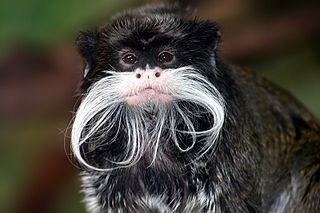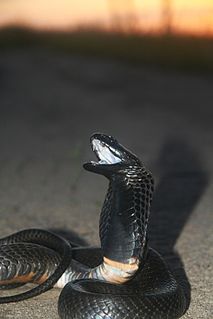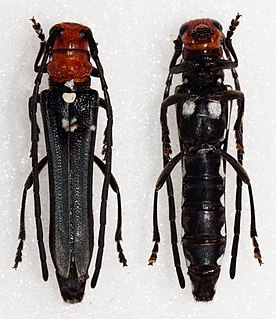Related Research Articles

The Callitrichidae are a family of New World monkeys, including marmosets, tamarins, and lion tamarins. At times, this group of animals has been regarded as a subfamily, called the Callitrichinae, of the family Cebidae.

The black-necked grebe or eared grebe is a member of the grebe family of water birds. It was described in 1831 by Christian Ludwig Brehm. There are currently three accepted subspecies, including the nominate subspecies. Its breeding plumage features a distinctive ochre-coloured plumage which extends behind its eye and over its ear coverts. The rest of the upper parts, including the head, neck, and breast, are coloured black to blackish brown. The flanks are tawny rufous to maroon-chestnut, and the abdomen is white. When in its non-breeding plumage, this bird has greyish-black upper parts, including the top of the head and a vertical stripe on the back of the neck. The flanks are also greyish-black. The rest of the body is a white or whitish colour. The juvenile has more brown in its darker areas. The subspecies californicus can be distinguished from the nominate by the former's usually longer bill. The other subspecies, P. n. gurneyi, can be differentiated by its greyer head and upper parts and by its smaller size. P. n. gurneyi can also be told apart by its lack of a non-breeding plumage. This species is present in parts of Africa, Eurasia, and the Americas.

The black-necked weaver is a resident breeding bird species in much of tropical Africa from Senegal and northern Angola to South Sudan and Tanzania.

The tamarins are squirrel-sized New World monkeys from the family Callitrichidae in the genus Saguinus. They are the first offshoot in the Callitrichidae tree, and therefore are the sister group of a clade formed by the lion tamarins, Goeldi's monkeys and marmosets.

The Black-necked Crane is a medium-sized crane in Asia that breeds on the Tibetan Plateau and remote parts of India and Bhutan. It is 139 cm (55 in) long with a 235 cm (7.8 ft) wingspan, and it weighs 5.5 kg (12 lbs). It is whitish-gray, with a black head, red crown patch, black upper neck and legs, and white patch to the rear of the eye. It has black primaries and secondaries. Both sexes are similar. Some populations are known to make seasonal movements. It is revered in Buddhist traditions and culturally protected across much of its range. A festival in Bhutan celebrates the bird while the Indian union territory of Ladakh has designated it as the state bird.

The black-mantled tamarin, Leontocebus nigricollis, is a species of saddle-back tamarin from the northwestern Amazon in far western Brazil, southeastern Colombia, northeastern Peru and eastern Ecuador.

The Indian hare, also known as the black-naped hare, is a common species of hare native to the Indian subcontinent, and Java.

The yellow-bellied seedeater is a species of bird in the family Thraupidae, formerly placed with the American sparrows in the Emberizidae.

The black-necked spitting cobra is a species of spitting cobra found mostly in sub-Saharan Africa. They are moderately sized snakes that can grow to a length of 1.2 to 2.2 m in length. Their coloration and markings can vary considerably. They prey primarily on small rodents. They possess medically significant venom, although the mortality rate for untreated bites on humans is relatively low. Like other spitting cobras, they can eject venom from their fangs when threatened. The neurotoxic venom irritates the skin, causing blisters and inflammation, and can cause permanent blindness if the venom makes contact with the eyes and is not washed off.

Saperdini is a tribe of longhorn beetles of the subfamily Lamiinae.

Leuconitocris is a genus of longhorn beetles of the subfamily Lamiinae, containing the following species:
Leuconitocris microphthalma is a species of beetle in the family Cerambycidae. It was described by Stephan von Breuning in 1950, originally under the genus Nitocris. It is known from Sierra Leone and the Democratic Republic of the Congo.
Leuconitocris subjuvenca is a species of beetle in the family Cerambycidae. It was described by Stephan von Breuning in 1950.
Leuconitocris argyrostigma is a species of beetle in the family Cerambycidae. It was described by Per Olof Christopher Aurivillius in 1914.
Leuconitocris argenteovittata is a species of beetle in the family Cerambycidae. It was described by Per Olof Christopher Aurivillius in 1914.
Leuconitocris angustifrons is a species of beetle in the family Cerambycidae. It was described by Harold in 1878.
Leuconitocris buettneri is a species of beetle in the family Cerambycidae. It was described by Hermann Julius Kolbe in 1893.
Leuconitocris nigricornis is a species of beetle in the family Cerambycidae. It was described by Olivier in 1795, originally under the genus Necydalis. It is known from Tanzania, South Africa, the Central African Republic, Mozambique, Uganda, Malawi, and Zambia.
Leuconitocris schultzei is a species of beetle in the family Cerambycidae. It was described by Hintz in 1919.
Leuconitocris tibialis is a species of beetle in the family Cerambycidae. It was described by Kolbe in 1893, originally under the genus Nitocris. It contains the varietas Leuconitocris tibialis var. holoflava.
References
- ↑ BioLib.cz - Leuconitocris nigricollis. Retrieved on 8 September 2014.